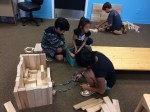In common conception, the work of art is often identified with the building, book, painting, or statue in its existence apart from human experience. Since the actual work of art is what the product does with and in experience, the result is not favorable to understanding. – John Dewey, Art as Experience (1934).
 We had a ribbon cutting ceremony last week. No, it wasn’t with donors and stakeholders involved with our new K-4 Village construction project. Rather, it was with middle school students who had completed their work with Ms. Fox over two enrichment cycles to redesign our Block Room! After a temporary closure for this work, our Block Room is officially reopened for learning!
We had a ribbon cutting ceremony last week. No, it wasn’t with donors and stakeholders involved with our new K-4 Village construction project. Rather, it was with middle school students who had completed their work with Ms. Fox over two enrichment cycles to redesign our Block Room! After a temporary closure for this work, our Block Room is officially reopened for learning!
We opened our Block Room last school year, and in doing so, added an exciting new element to our educational program. If you don’t know, our Block Room is exactly what you think it is; a room full of beautiful wooden blocks for our students to imagine, design and build with. Unfortunately, because of the location of the K-4 Village construction project on campus, we had to relocate the Block Room after only one year. We needed to move the room quickly and while it was still an excellent space, we decided we could make it even better. So, we turned the redesign over to the fabulous Christin Fox and 18 middle school students. The transformation they made was breathtaking.
The project was a great example of how we approach teaching and learning here at Assets. It’s not hard to imagine a project like this at another school where students were given the assignment to share ideas for the room redesign, or even create their own room designs via art sketch or some digital graphic design software, before turning it over to the adults and professionals to do the work. Certainly, those projects can be beneficial for kids. What is unique about Assets is that we try to let the students see the project through to completion when possible. Not only did our students design the room, they moved the furniture, laid the drop cloths, stood on step-ladders and painted the walls. It was authentic learning. There was an authentic problem that required authentic solutions, and along the way encountered authentic questions, challenges, and new learning. If you want to do real work, you need to use real tools. You know you’ve given a meaningful assignment when you see students working on their paintings during their lunch time!
Our new Block Rooms now features an Inspiration Wall full of photos of student creations, a Masterpiece Wall where we can hang photos of particularly impressive block structures, and a nearly completed visual glossary of block names and shapes. The students also painted one full wall as a chalkboard, from ceiling to floor, so students can visibly capture their brainstorming, questions, or draw backgrounds to their block creations.

Mahalo to Emma, Kayla, Sailor, Rebekah, Aspen, Cole, Mairi, Tyler, Kyle, Puna, Graci, Grant, Shanie, Soren, Michael, Hailey, Luke and Paris!
These students have given their school a great gift. They’ve created a space filled with joy and wonder. They created a space where others can gather to be creative, curious and imaginative, and where we also further develop our problem-solving and collaboration skills.
As a follow-up, please look for the upcoming Part 2 of this post, where I will share the value of blocks in learning and all the wonderful ways we are using this room.
Aloha,
Ryan
About the Author
 Ryan Masa is the K-8 Principal at Assets School in Honolulu, Hawaii
Ryan Masa is the K-8 Principal at Assets School in Honolulu, Hawaii













Pingback: Why We Play with Blocks | Assets School K-8 Principal Blog
January 22, 2018 at 4:07 pm
Ryan, excellent! You’re setting the bar very high for the next Assets K-8 Principal. I appreciate how you put this into a two part blog, ending with the rationale.
On Mon, Jan 22, 2018 at 2:52 PM, Assets School K-8 Principal Blog wrote:
> Ryan Masa posted: “In common conception, the work of art is often > identified with the building, book, painting, or statue in its existence > apart from human experience. Since the actual work of art is what the > product does with and in experience, the result is not favorable ” >
LikeLike